Graph Neural Network-Based Beamforming Optimization for Multi-BS RIS-Aided Communication Systems
Abstract
1. Introduction
1.1. Related Work
1.2. Contribution and Novelty of This Paper
2. System Model and Problem Formulation
2.1. Single-BS RIS-Aided System: Model and Limitations
2.2. Multi-BS RIS-Aided System: Architecture and Advantages
2.3. Channel Modeling Approaches for the Multi-BS System
2.3.1. The Computational Model (Horizontal Concatenation)
2.3.2. The Structural Model (Block-Diagonal)
2.3.3. Model Selection
2.4. Signal Transmission and Problem Formulation
3. Beamforming Optimization Techniques
3.1. Baseline Heuristic Techniques
| Algorithm 1: SVD-Based RIS Phase Shift Optimization for a Single Link |
Input: (BS→RIS), (RIS→User) Perform singular-value decomposition on the RIS–BS covariance: then extract the right singular matrix V Select the first columns: Form the phase-mapping matrix and extract its diagonal entries: Build the phase-shift matrix: Output: (optimized RIS phase matrix) |
3.2. Proposed GNN-Based Solver
3.2.1. Overall Architecture
3.2.2. Core Components and Mechanism
3.2.3. Cost Definition for AI Solvers
4. Performance Evaluation
4.1. Experimental Setup
4.2. Results and Analysis
4.2.1. System Architecture Comparison: Single-BS vs. Multi-BS
4.2.2. Input Strategy for GNN Solvers: Direct vs. Feature-Based
4.2.3. Performance Comparison of Feature-Based AI Solvers
4.2.4. Comprehensive Cost Efficiency Analysis
5. Discussion
Limitations and Future Work
6. Conclusions
Author Contributions
Funding
Institutional Review Board Statement
Informed Consent Statement
Data Availability Statement
Conflicts of Interest
References
- Wu, Q.; Zhang, R. Towards Smart and Reconfigurable Environment: Intelligent Reflecting Surface Aided Wireless Network. IEEE Commun. Mag. 2020, 58, 106–112. [Google Scholar] [CrossRef]
- Basar, E.; Di Renzo, M.; De Rosny, J.; Debbah, M.; Alouini, M.S.; Zhang, R. Wireless Communications Through Reconfigurable Intelligent Surfaces. IEEE Access 2019, 7, 116753–116773. [Google Scholar] [CrossRef]
- Basar, E.; Alexandropoulos, G.C.; Liu, Y.; Wu, Q.; Jin, S.; Yuen, C.; Dobre, O.A.; Schober, R. Reconfigurable Intelligent Surfaces for 6G: Emerging Hardware Architectures, Applications, and Open Challenges. IEEE Veh. Technol. Mag. 2024, 19, 27–47. [Google Scholar] [CrossRef]
- Pan, C.; Ren, H.; Wang, K.; Xu, W.; Elkashlan, M.; Nallanathan, A.; Hanzo, L. Multicell MIMO Communications Relying on Intelligent Reflecting Surfaces. IEEE Trans. Wirel. Commun. 2020, 19, 5218–5233. [Google Scholar] [CrossRef]
- Guo, H.; Liang, Y.C.; Chen, J.; Larsson, E.G. Weighted Sum-Rate Maximization for Reconfigurable Intelligent Surface Aided Wireless Networks. IEEE Trans. Wirel. Commun. 2020, 19, 3064–3076. [Google Scholar] [CrossRef]
- You, C.; Zheng, B.; Zhang, R. Wireless Communication via Double IRS: Channel Estimation and Passive Beamforming Designs. IEEE Wirel. Commun. Lett. 2021, 10, 431–435. [Google Scholar] [CrossRef]
- Wu, Q.; Zhang, R. Beamforming Optimization for Wireless Network Aided by Intelligent Reflecting Surface With Discrete Phase Shifts. IEEE Trans. Commun. 2020, 68, 1838–1851. [Google Scholar] [CrossRef]
- Zhou, X.; Fang, T.; Mao, Y. Joint Active and Passive Beamforming Optimization for Beyond Diagonal RIS-Aided Multi-User Communications. IEEE Commun. Lett. 2025, 29, 517–521. [Google Scholar] [CrossRef]
- Di Renzo, M.; Zappone, A.; Debbah, M.; Alouini, M.S.; Yuen, C.; de Rosny, J.; Tretyakov, S. Smart Radio Environments Empowered by Reconfigurable Intelligent Surfaces: How It Works, State of Research, and The Road Ahead. IEEE J. Sel. Areas Commun. 2020, 38, 2450–2525. [Google Scholar] [CrossRef]
- Sun, H.; Liu, Y.; Al-Tahmeesschi, A.; Nag, A.; Soleimanpour, M.; Canberk, B.; Arslan, H.; Ahmadi, H. Advancing 6G: Survey for Explainable AI on Communications and Network Slicing. IEEE Open J. Commun. Soc. 2025, 6, 1372–1412. [Google Scholar] [CrossRef]
- Shi, E.; Zhang, J.; An, J.; Zhang, G.; Liu, Z.; Yuen, C.; Ai, B. Joint AP-UE Association and Precoding for SIM-Aided Cell-Free Massive MIMO Systems. IEEE Trans. Wirel. Commun. 2025, 24, 5352–5367. [Google Scholar] [CrossRef]
- Wang, J.; Ma, C.; Gong, S.; Yang, X.; Ma, S. Joint Beamforming Optimization and Mode Selection for RDARS-Aided MIMO Systems. IEEE Trans. Wirel. Commun. 2024, 23, 17557–17572. [Google Scholar] [CrossRef]
- Chen, W.; Wen, C.K.; Li, X.; Jin, S. Channel Customization for Joint Tx-RISs-Rx Design in Hybrid mmWave Systems. IEEE Trans. Wirel. Commun. 2023, 22, 8304–8319. [Google Scholar] [CrossRef]
- Taha, A.; Alrabeiah, M.; Alkhateeb, A. Enabling Large Intelligent Surfaces With Compressive Sensing and Deep Learning. IEEE Access 2021, 9, 44304–44321. [Google Scholar] [CrossRef]
- Wu, Z.; Pan, S.; Chen, F.; Long, G.; Zhang, C.; Yu, P.S. A Comprehensive Survey on Graph Neural Networks. IEEE Trans. Neural Netw. Learn. Syst. 2021, 32, 4–24. [Google Scholar] [CrossRef] [PubMed]
- Shen, Y.; Shi, Y.; Zhang, J.; Letaief, K.B. Graph Neural Networks for Scalable Radio Resource Management: Architecture Design and Theoretical Analysis. IEEE J. Sel. Areas Commun. 2021, 39, 101–115. [Google Scholar] [CrossRef]
- Shen, Y.; Zhang, J.; Song, S.H.; Letaief, K.B. Graph Neural Networks for Wireless Communications: From Theory to Practice. IEEE Trans. Wirel. Commun. 2023, 22, 3554–3569. [Google Scholar] [CrossRef]
- Mao, Y.; Yu, X.; Huang, K.; Zhang, Y.J.A.; Zhang, J. Green Edge AI: A Contemporary Survey. Proc. IEEE 2024, 112, 880–911. [Google Scholar] [CrossRef]
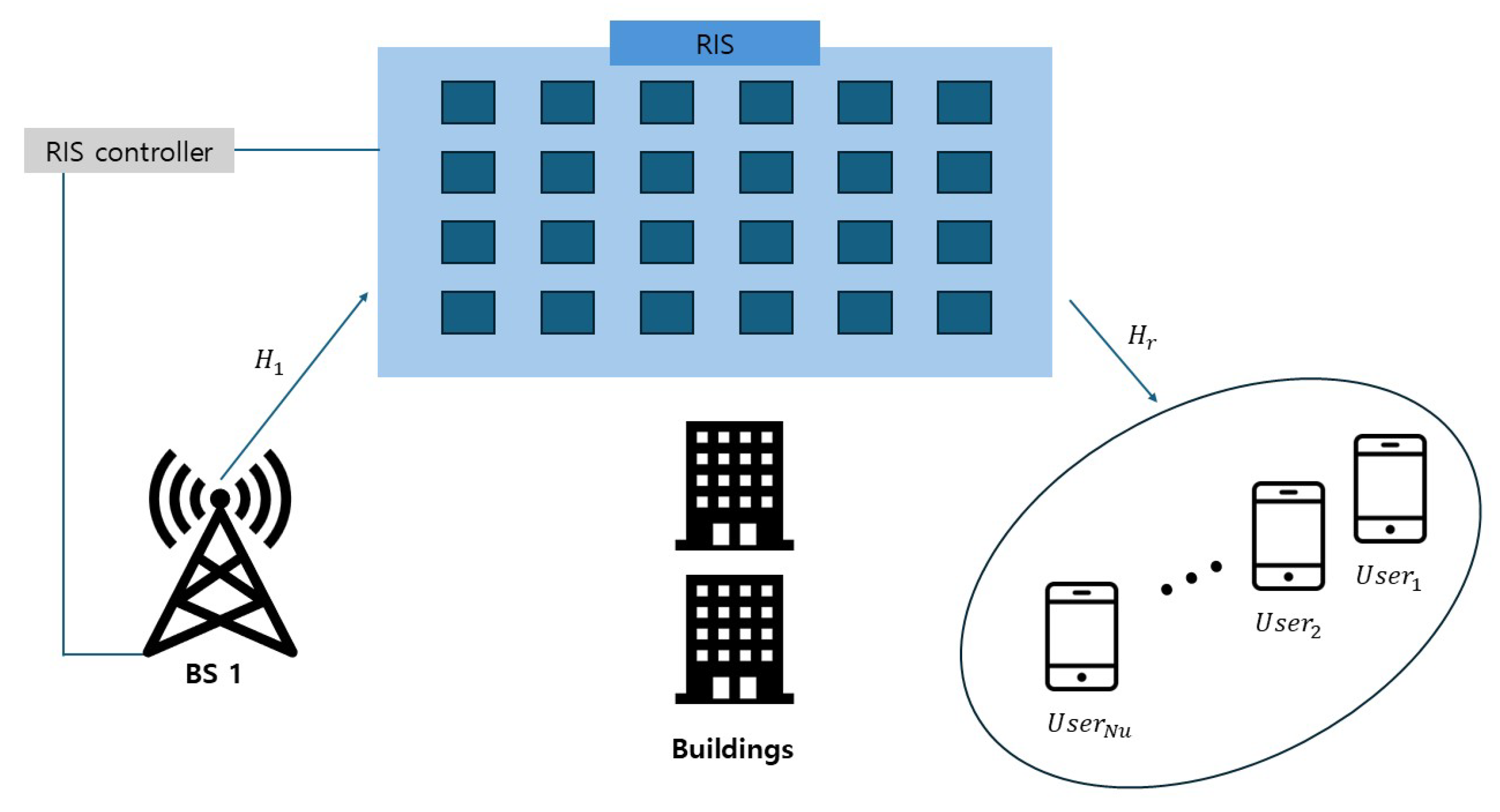

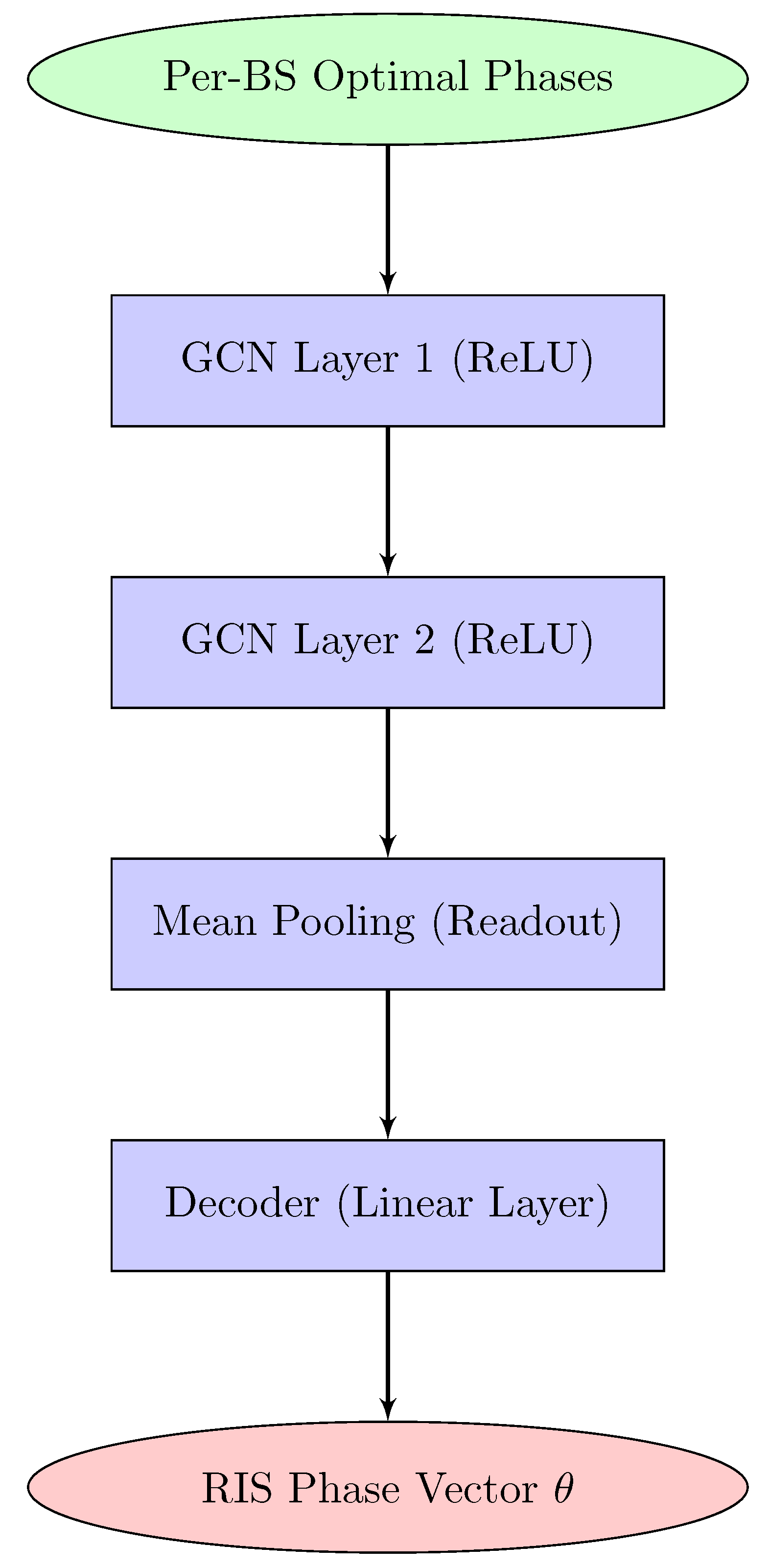


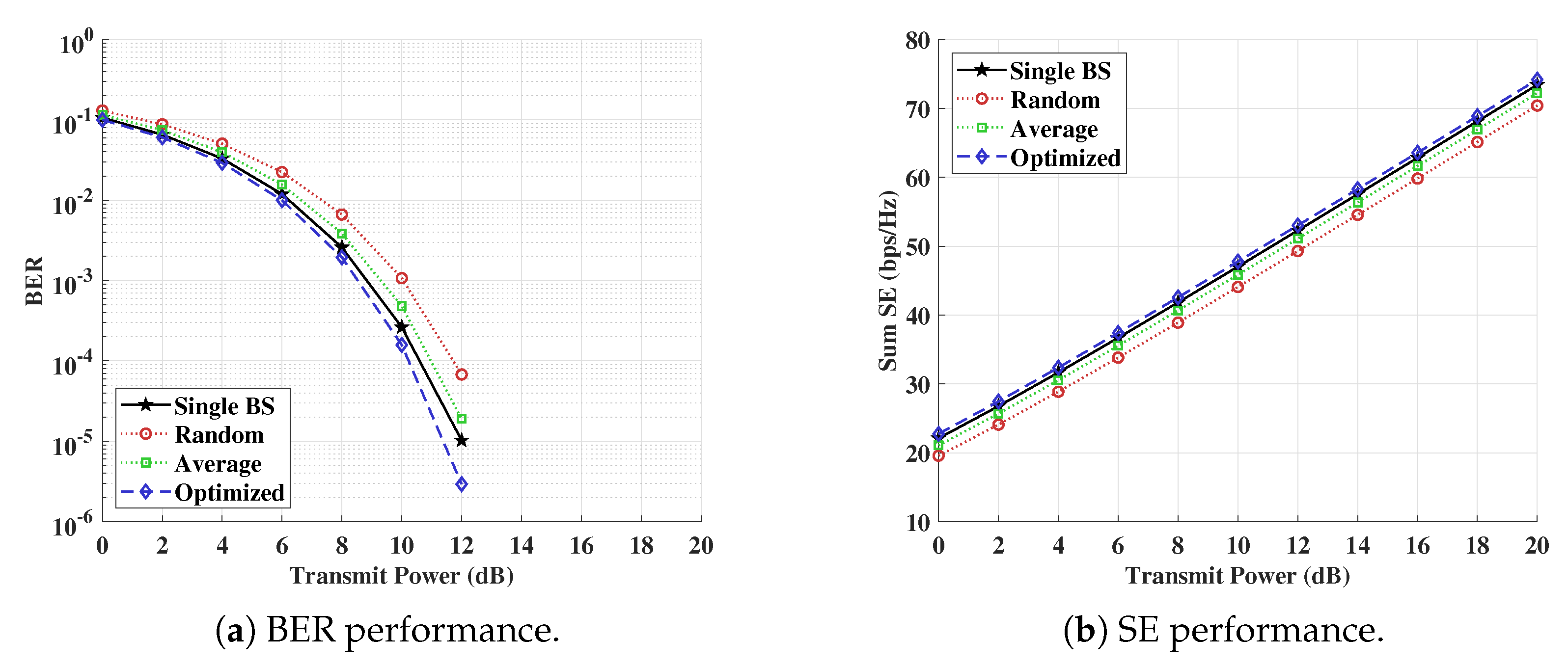
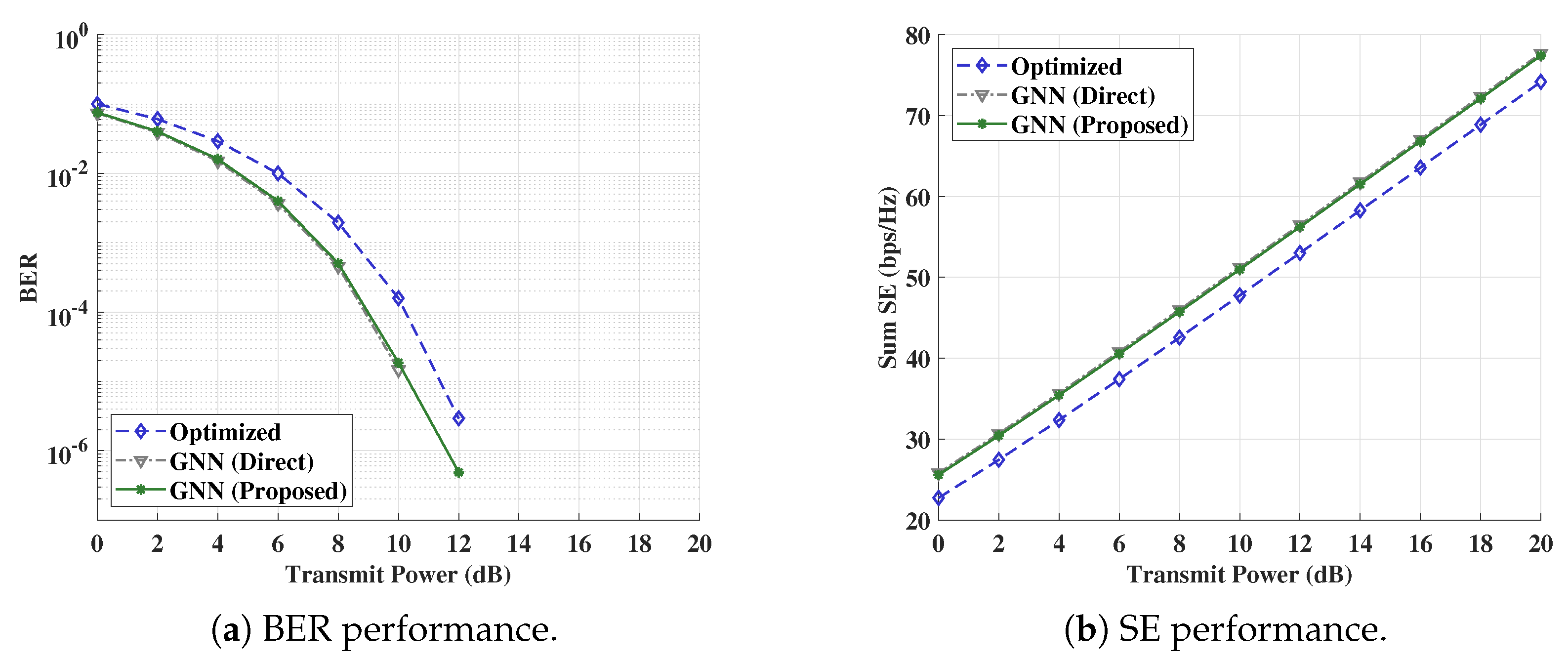
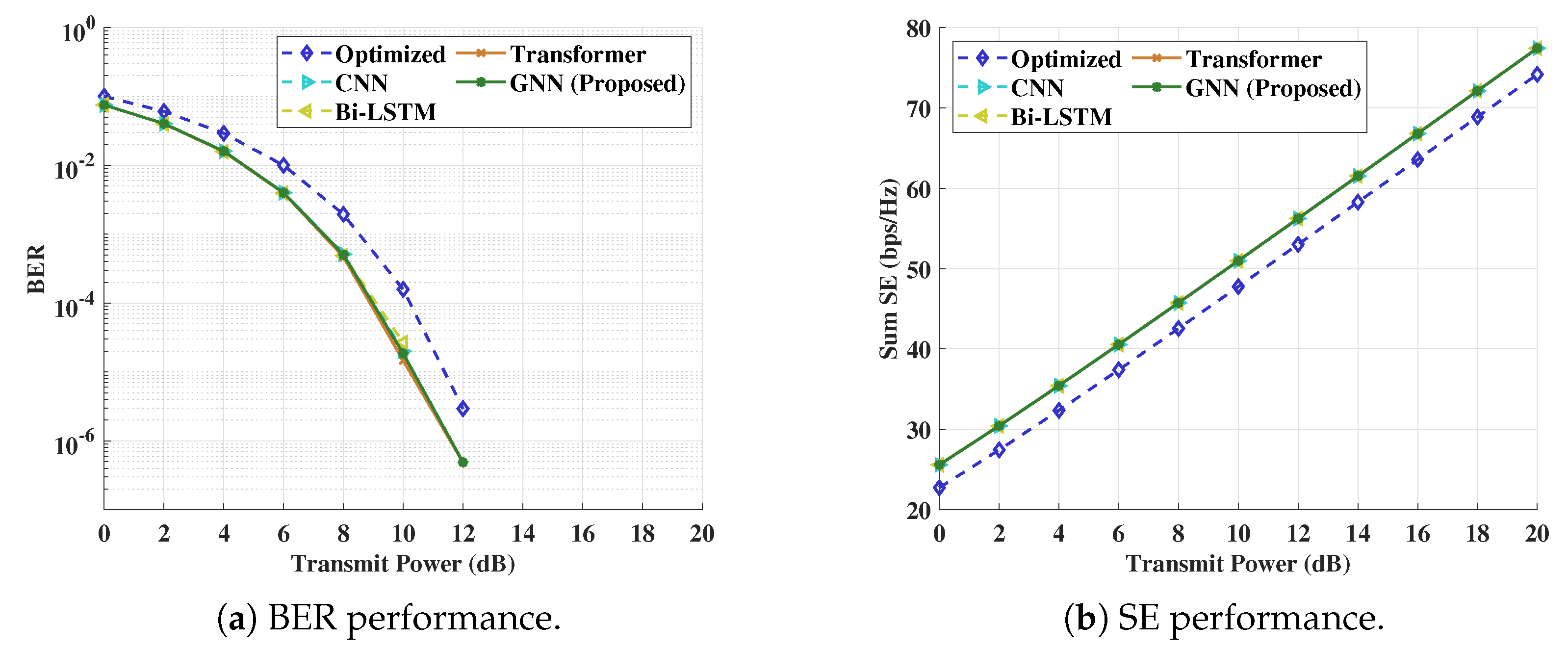
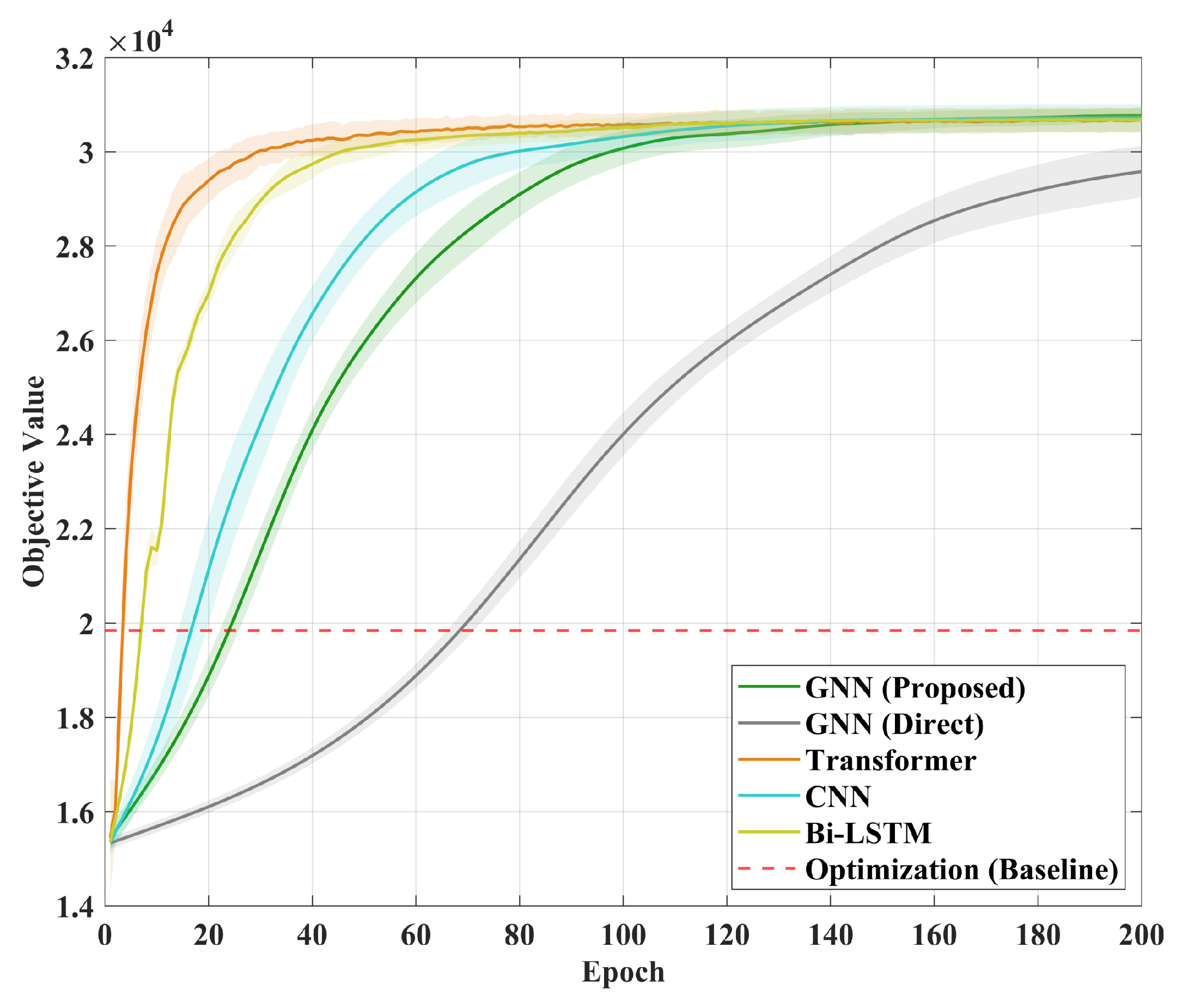
| Parameter | Value |
|---|---|
| Number of BSs (K) | 4 |
| Antennas per BS () | 8 |
| Number of Users () | 8 |
| Number of RIS elements () | 64 |
| Channel Model | Rayleigh Fading |
| Modulation Scheme | 16-QAM |
| Transmit Power (P) | 0 to 20 dB |
| Noise Model | AWGN |
| Model | Layer/Input Details | Shape |
|---|---|---|
| GNN (Proposed) | Input Features (SVD-based) | () |
| GCN Layer 1 (32 units) | (, 32) | |
| GCN Layer 2 (64 units) | (, 64) | |
| Linear Decoder | () | |
| GNN (Direct) | Input Features (Raw Channel) | () |
| GCN Layer 1 (128 units) | (, 128) | |
| GCN Layer 2 (256 units) | (, 256) | |
| Linear Decoder | () | |
| CNN | Input Image (SVD-based) | (8, 8, ) |
| Conv2D Layer 1 (16 filters, 3 × 3 kernel) | (8, 8, 16) | |
| Conv2D Layer 2 (32 filters, 3 × 3 kernel) | (8, 8, 32) | |
| Linear Layer (64 units) | (64) | |
| Linear Decoder | () | |
| Bi-LSTM | Input Sequence (SVD-based) | () |
| 2-layer Bi-LSTM (128 hidden units) | (, 256) | |
| Linear Decoder | () | |
| Transformer | Input Sequence (SVD-based) | () |
| Input Projection (Linear, 64 units) | (, 64) | |
| Self-Attention Encoder (3 layers, 4 heads/layer) | (, 64) | |
| Linear Decoder | () | |
| Common Training Hyperparameters | ||
| Optimizer | Adam | |
| Learning Rate | for GNN (Direct), for all other models | |
| Scheduler | ReduceLROnPlateau (patience = 20, factor = 0.5) | |
| Training Epochs | 200 | |
| Solver Method | Objective | Total MFLOPs | Inf. MFLOPs | Params. (K) | Perf./Param. |
|---|---|---|---|---|---|
| Technique 3 (Optimized) | 2.155 | ∼266 | - | - | - |
| GNN (Proposed) | 3.077 | ∼144 | 0.24 | 6.6 | 4.69 |
| CNN | 3.071 | ∼228 | 0.38 | 12.1 | 2.54 |
| Transformer | 3.071 | ∼30,282 | 50.47 | 848.2 | 0.04 |
| Bi-LSTM | 3.068 | ∼20,772 | 34.62 | 553.0 | 0.06 |
| GNN (Direct) | 2.958 | ∼1884 | 3.14 | 59.8 | 0.49 |
Disclaimer/Publisher’s Note: The statements, opinions and data contained in all publications are solely those of the individual author(s) and contributor(s) and not of MDPI and/or the editor(s). MDPI and/or the editor(s) disclaim responsibility for any injury to people or property resulting from any ideas, methods, instructions or products referred to in the content. |
© 2025 by the authors. Licensee MDPI, Basel, Switzerland. This article is an open access article distributed under the terms and conditions of the Creative Commons Attribution (CC BY) license (https://creativecommons.org/licenses/by/4.0/).
Share and Cite
Seo, S.-H.; Choi, S.-G.; Yu, J.-H.; Choi, Y.-J.; Tong, K.-C.; Choi, M.-H.; Jung, Y.-G.; Song, H.-K.; You, Y.-H. Graph Neural Network-Based Beamforming Optimization for Multi-BS RIS-Aided Communication Systems. Mathematics 2025, 13, 2732. https://doi.org/10.3390/math13172732
Seo S-H, Choi S-G, Yu J-H, Choi Y-J, Tong K-C, Choi M-H, Jung Y-G, Song H-K, You Y-H. Graph Neural Network-Based Beamforming Optimization for Multi-BS RIS-Aided Communication Systems. Mathematics. 2025; 13(17):2732. https://doi.org/10.3390/math13172732
Chicago/Turabian StyleSeo, Seung-Hwan, Seong-Gyun Choi, Ji-Hee Yu, Yoon-Ju Choi, Ki-Chang Tong, Min-Hyeok Choi, Yeong-Gyun Jung, Hyoung-Kyu Song, and Young-Hwan You. 2025. "Graph Neural Network-Based Beamforming Optimization for Multi-BS RIS-Aided Communication Systems" Mathematics 13, no. 17: 2732. https://doi.org/10.3390/math13172732
APA StyleSeo, S.-H., Choi, S.-G., Yu, J.-H., Choi, Y.-J., Tong, K.-C., Choi, M.-H., Jung, Y.-G., Song, H.-K., & You, Y.-H. (2025). Graph Neural Network-Based Beamforming Optimization for Multi-BS RIS-Aided Communication Systems. Mathematics, 13(17), 2732. https://doi.org/10.3390/math13172732






